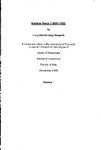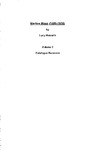Marlow Moss (1889-1958)
| dc.contributor.author | Howarth, Lucy Harriet Amy | |
| dc.contributor.other | Faculty of Arts, Humanities and Business | en_US |
| dc.date.accessioned | 2013-11-01T12:33:13Z | |
| dc.date.available | 2013-11-01T12:33:13Z | |
| dc.date.issued | 2008 | |
| dc.identifier | NOT AVAILABLE | en_US |
| dc.identifier.uri | http://hdl.handle.net/10026.1/2528 | |
| dc.description | Merged with duplicate record 10026.1/831 on 15.02.2017 by CS (TIS) | |
| dc.description.abstract |
This thesis is the first full-length academic study of Marlow Moss in English. The methodology of this research has been to combine biographical, historical, and analytical approaches, and the chapters (a literature review; a biographical account; an examination of gender I identity issues; a European art historical perspective; a British art historical perspective; and a critical analysis of Moss's oeuvre), function as thematic lenses through which to view Moss. It could seem that Moss's historical position, a British artist working in Europe and a European-influenced artist working in England, should have secured her a more prominent role in the history of British Constructive Art. Moss's subsequent neglect provokes questions about the construction of that history. The impetus of this research has been the retrieval of a lost personality in British and European Modernist Art. This thesis represents the most complete account of Moss's life and work to date, and the most sustained examination of her aesthetic. Gathered in the Catalogue Raisonne in appendix to this thesis are over a hundred recorded works by Moss, with images whenever possible, with all currently available information and details of provenance. Also accompanying this thesis are reproductions of photographs, of Moss and of her works, hitherto inaccessible in private collections. This research has gathered and collated extensive archival material, ranging from contemporary reviews of Moss exhibitions, to all known manuscript material relating to Moss, including unpublished letters such as those held in the Paule Vezelay Collection of the Tale Archives, which remain un-catalogued at the time of writing. Moss's relationship with Mondrian, the focus of much previous research, is addressed and clarified in this thesis. The significance of Moss's connections to Paris, the Academie Moderne and Leger, and Abstraction-Creation, and her relationship to her contemporaries, particularly Georges Vantongerloo and Max Bill, are traced. Her position in British art history is mapped, with particular attention to her exhibitions in London during the fifties. Beyond establishing Moss's absence from art historical narratives, and examining the circumstances of her neglect, this thesis primarily seeks to retrieve the position she did occupy, by exploring her working aesthetic and situating it within a specific historical and theoretical context. This context includes Moss's sexuality and the questions it raises for a critical evaluation of her achievement. Although both feminist and Queer Theorist paradigms are pertinent to this research, and are indeed included in this study, Moss is found to problematise existent theoretical categories. Moss's neglect may thus be explained by her lack of fit with prevalent historical and theoretical approaches to Constructivism, to British Modernism, and to the gendering of arts practice. | en_US |
| dc.language.iso | en | en_US |
| dc.publisher | University of Plymouth | en_US |
| dc.title | Marlow Moss (1889-1958) | en_US |
| dc.type | Thesis | |
| plymouth.version | Full version: final and full version as approved by the examiners at the time of the award of your degree | en_US |
| dc.identifier.doi | http://dx.doi.org/10.24382/4114 |
Files in this item
This item appears in the following Collection(s)
-
01 Research Theses Main Collection
Research Theses Main




